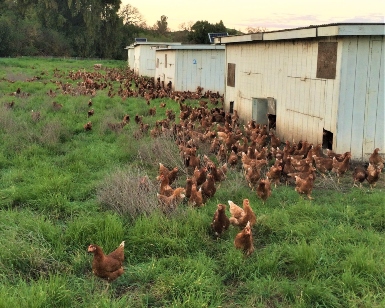San Rafael, CA – Historic drought conditions that challenged Marin County’s agricultural producers for almost four years are prominently reflected in the new 2022 Marin County Crop & Livestock Report.
 One of the bright spots in the 2022 Marin County Crop & Livestock Report was the 8% increase over the previous year in the value of livestock, which includes poultry.
One of the bright spots in the 2022 Marin County Crop & Livestock Report was the 8% increase over the previous year in the value of livestock, which includes poultry.The report, publicly released June 20 before the Board of Supervisors, covers a block of time before the 2022-23 winter arrived to soothe and restore parched lands. Agricultural production in Marin dipped 3% in 2022, following a 5% slide a year earlier, all closely tied to a drought that forced farmers to fallow more of their land.
Agricultural Commissioner Stefan Parnay and Inspector Allison Klein presented the new report, which showed an estimated gross total production value of local products of $94,147,000. The value in 2021 was $96,656,000. The local record is $111,061,000 in 2015.
The brightest news in the report was the 28% increase in the value of fruits and vegetables. Late spring rains helped many growers reestablish land that had been fallowed the year prior. There was a 30% boost in acres of fruits and vegetables planted compared to 2021.
For the fifth consecutive year, Marin’s top three commodities were organic milk, poultry, and cattle with a combined value of $70 million, or roughly 75% of the total gross value of all agricultural production. The value of livestock (cattle, sheep, and poultry) was up (8%, 1%, and 3%, respectively). Many ranchers were able to maintain herd sizes from 2021, but cautiously await increasing herd sizes while the long-term impacts of the drought are determined. The value of locally produced organic milk ($32 million) far outpaces the value of conventional milk ($2 million).
The good-news points in this year’s report helped offset downturns in aquaculture (27%) and field crops (11%). The amount of harvested silage and hay from fields was down (20% and 19%, respectively) due to continued lack of water.
“Despite extraordinary challenges, agricultural producers have shown remarkable resiliency and steadfastness in adapting to the unpredictability of the times,” Parnay said. “Their resourcefulness, hopefulness, patience, and fortitude are commendable as they continue to work toward a brighter future.”
During the drought, ponds and wells on local ranches ran dry and many farmers and ranchers resorted to an expensive step: hauling in water to support their ag operations. Fallowing fields and selling off animals were among other drastic measures that ranchers had been forced to consider. For part of 2022, the lingering COVID-19 pandemic required agricultural producers to deal with labor shortages, high fuel and feed costs, and the need to find new markets for products.
This year’s report features Marin’s rich organic farming heritage. “With over 75 organic operations, we wanted to share the stories of some of our innovative organic farmers and ranchers,” Klein told the Board members. In 2022, Marin farms produced over $39 million worth of organic agricultural products and farmed over 51,000 acres organically.
The annual report includes updates on pest prevention programs, sudden oak death, invasive weed management, and the organic certification program.
All Marin County livestock and crop reports are online, including the new one. Reports are sent to the California Department of Food and Agriculture to be included in statewide reports.